https://youtu.be/8GVwFGFWsHk
Muzzle brakes tame recoil, but almost without fail take an already-loud gun and crank up the noise, blast, and, most notably, concussion levels experienced by the shooter and those around him or her even further. For shooters wanting a more pleasant experience, the choice is either permanently sacrificing recoil reduction by using a tamer muzzle device or purchasing one that comes with a proprietary blast shield. Indian Creek Designs has resolved both of these concerns with their Blast Forwarding Device, or BFD.
The BFD installs and removes very quickly and easily, and is a near-universal design. It can be used with any muzzle brake, compensator, or flash hider with a 1-inch or smaller diameter. The brake of your choosing when you want it, a blast shield when you don’t.
The first step is installing the mounting collar onto your rifle’s muzzle. The collar isn’t threaded on the inside, so it’s a very easy matter of just sliding it on. Again, because it isn’t threaded internally, it’ll fit on any 1/2-inch diameter thread pattern; most commonly that’ll be 1/2-28 and 1/2-36. There’s also a version for muzzles threaded 5/8-24 or 14mm.
With that done, install the muzzle device of your choice via your method of choice. Crush washer, shim, etc. The BFD mount collar is now clamped firmly in place, and the muzzle device doesn’t know any better. The mount collar overlaps the barrel by about 0.65″, so make sure you have clearance for it. ID of the mount collar where it overlaps the barrel is about 0.779″.
In addition to a 1″ maximum outer diameter for your muzzle device, the length of that muzzle device is another consideration. Sure, it can extend out the front of the BFD to an unlimited length, but for the BFD to be as effective as possible the brake should stay within it. I’d suggest sticking to muzzle devices of approximately 2.25″ OAL or shorter if you want the front to be flush or recessed with the front of the BFD. Of course, the front can stick out as long as the last baffle/port is still inside, so there’s some fudge room in the measurements here.
On The Range
I joked in the video that BFD may as well stand for Big F’ing Difference, because a big f’ing difference it does, indeed, make. Totally night-and-day for the shooter, and based on the maple tree that was abused by my brake, for anybody around the shooter. In five seconds it switches from a chest thumping, blast spitting brake to a very effective linear compensator. Then back to the brake just as quickly.
Shooting a competition stage, target shooting outdoors, or otherwise looking for that recoil reduction and muzzle stability? Run the bare brake. Shooting indoors or on a range with people to either side? Pop the BFD on.
It’s also about as good a choice as possible — given a suppressor isn’t an option for whatever reason — if you’re forced to fire a gun without hearing protection, such as in a home defense situation. While it doesn’t reduce the volume of the gunshot at all, it does focus that volume, blast, and concussion forwards and away from the shooter. The difference is massive.
Nitpicks
The BFD is machined from Type III hardcoat anodized aluminum, which is great because it’s lightweight. In this application it’s also plenty strong enough and sufficiently durable. Indian Creek Design says they’ve tested it with thousands of rounds of magnum calibers running aggressive muzzle brakes and it holds up great. But, I’d still like to purchase a version with a steel mounting collar. Since it’s clamped between the muzzle device and the barrel, and it’s receiving the BFD shield over and over as I screw it on and take it off, I want extra insurance against screwing up those threads. With a lightweight, aluminum, easily-replaceable shield going on a comparatively difficult-to-replace mount, I’d like the mount to win a cross-threading fight.
When I got my BFD this option didn’t exist, but it looks like Indian Creek Design is rolling out a thread protector. Obviously that’s a great idea for range time sans blast shield.
One last gripe: the anodizing on my fairly early-production unit is a bit glossy for my taste, and it also has a purplish hue in some light (my camera exaggerated it a bit). As I’d expect the vast majority of these will end up on AR-pattern rifles, it would be nice if the finish closely matched that of typical, aluminum AR parts such as receivers — more of a matte black.
Conclusions
The Indian Creek Design BFD mount is easy to install initially — if you can install a muzzle device you can install this thing — and from there the blast shield is extremely easy and quick to put on and take off. The difference it makes is completely night-and-day. It’s lightweight and near-universal, working with any muzzle brake, compensator, or flash hider on the market with a diameter of 1″ or less.
Specifications: Indian Creek Design Blast Forwarding Device
Diameter: 1.49″
Length: 3.1″
Weight: 2.6 oz
Material: aluminum
Finish: Type III hardcoat anodizing
Fits: Available for 1/2″ and 5/8″ (14mm) muzzle thread diameters. Works with any muzzle device 1″ in diameter or narrower.
MSRP: $79.95 for mount plus shield. $29.95 for additional mounts (swap one shield between multiple rifles).
Ratings (out of five stars):
Efficacy * * * * *
It works great. BFD = Blast Forwarding Device = Big F’ing Difference.
Convenience * * * * *
Near-universal design; use the muzzle device of your choice. Easy-on, easy-off. BOOM to boom.
Fit & Finish * * * *
Machining is great. Everything is spot on about it, threads are clean, flats are square, no machine marks, and fit is exacting. I’m not a fan of the high-gloss, very slightly purply anodizing. I’ll probably hit it with some fine grit sandpaper then spray paint it with high-temp engine paint. Wouldn’t mind the option to get a steel mount, and maybe a steel or even titanium shield, and maybe a Cerakote option.
Overall * * * *
The BFD is extremely effective and convenient. No more compromising on muzzle device choice, having to sacrifice recoil reduction and muzzle control in order to avoid blast and concussion. I can now switch back and forth between those two worlds almost instantly. There is room for aesthetic improvements to be made to the blast shield, and even if Type III anodizing provides some fairly amazing surface hardness, I’m not convinced an aluminum mount is the best option.
The .223 ammunition used in the making of this review was provided by CapArms. Their sponsorship of most of TTAG’s review-related ammo needs is a huge help, allowing us to review more guns and more gear more thoroughly.

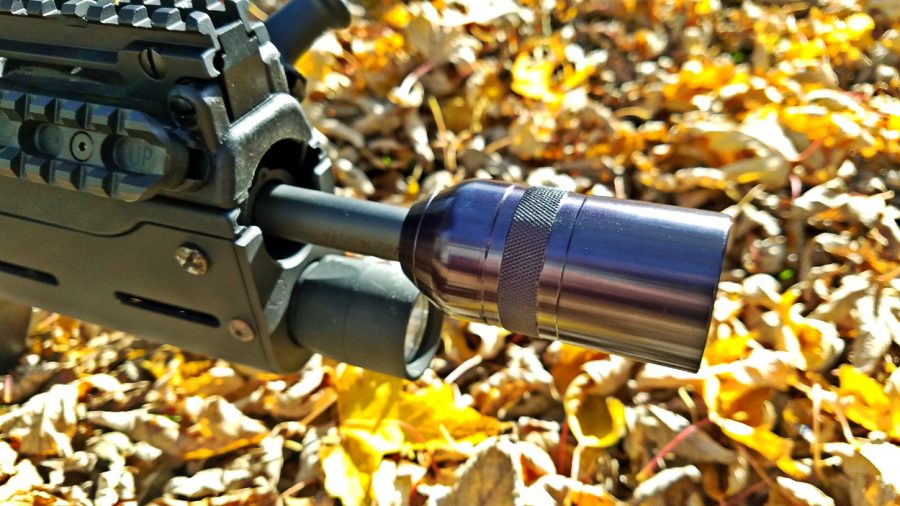
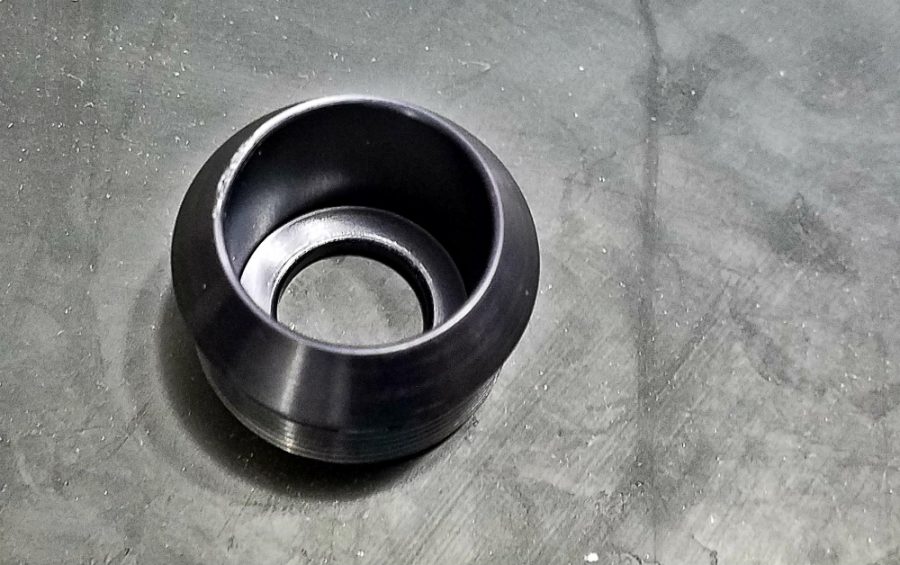
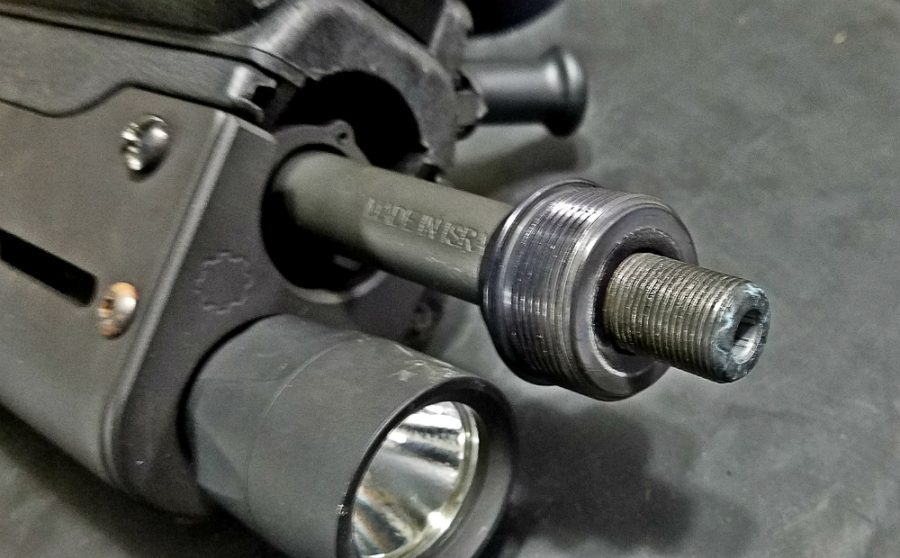

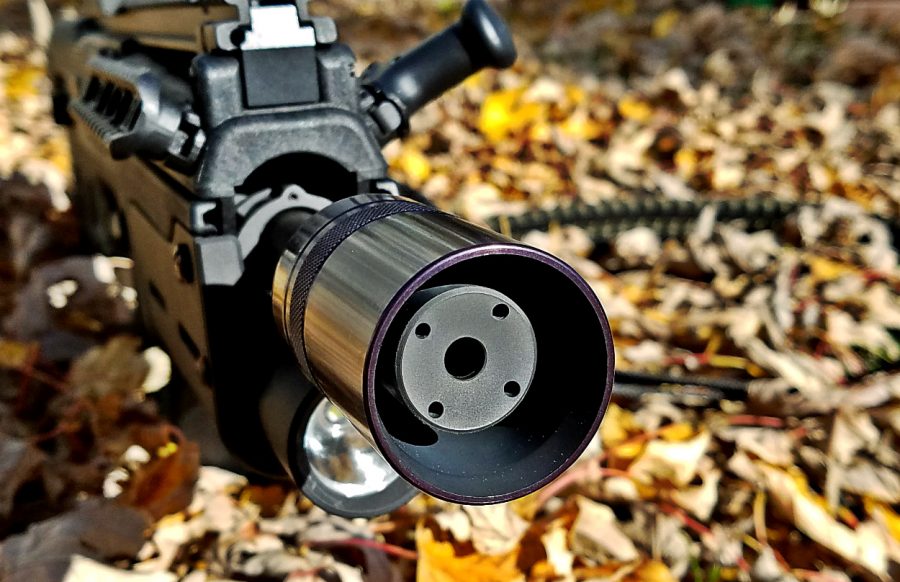
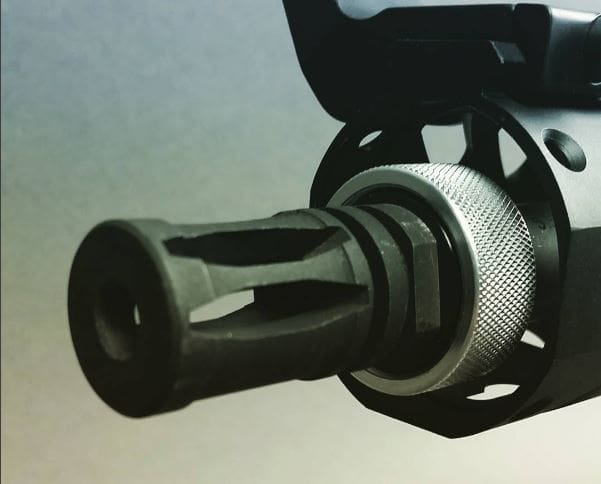




Seems like a smart idea mostly well executed. Wish I’d thought of it.
Also adds Han Soloness. Don’t deny it.
Ha! Now I can’t unsee.
so much different than the spoken word. me likey.
this thing reminds me of the “swarf collector” attachment for my hand drills.
Does this have a greater effect than just removing the brake?
Yes. In my subjective opinion there is less blast and concussion than a bare muzzle. It better focuses that forwards and downrange and the shooter experiences less.
Plus, of course, removing and reinstalling the brake is not anywhere near as convenient. That would require a wrench and a box of spare crush washers. The blast shield just threads on and off by hand in no time, and your perfectly-timed brake stays installed.
BTW I’ll be able to OBJECTIVELY measure concussion soon… Will be doing a big test with a bunch of brakes, bare muzzle, BFD, etc, measuring in a scientific way the amount of concussion that is experienced by the shooter in each case.
Thanks, I don’t run a brake on anything I own, nor would I on anything other than a lightweight rifle in a magnum caliber. But I’m always interested in something that reduced the noise and blast toward the shooter.
I’m very much looking forward to your concussion test. Any chance you’ll be testing the Precision Armament AFAB-556 and Black River Tactical Covert Comp? I’m currently running the AFAB after all the good things you had to say about it, but since I do most of my shooting with friends when camping, I’ve been considering the BRT due to everyone saying it reduces perceived noise and blast significantly better than an A2.
Yes, I’ll almost certainly be testing both of those. The Covert Comp, without question, does what you said. Of course, it would almost mean “permanently” changing out your muzzle device at the expense of recoil reduction and muzzle stability, etc (the Covert Comp and most linear compensators recoil just like a bare muzzle does). Another option could be this BFD system, where you can keep your AFAB or whatever brake/comp you wanted and just throw the shield on when your friends are next to you and take it right back off when they aren’t.
Would you be kind enough to also measure the increased recoil with the shield attached? So far, this sounds like an excellent addition to an AR.
Increased recoil vs. what? It’s going to vary depending on what muzzle device is on the muzzle to begin with…
Non-permanent blast shields are nice. I have the one from Griffin Armament, and my buddy has the Surefire one. But they’re mostly proprietary.
I really like ICD’s concept here! Been a fan of them since I bought my first paintball gun (lol) and it’s nice to see them in the firearms industry.
I probably should have mentioned in the review that not only is the BFD universal (or close to it) but it’s also like half the cost of most of the proprietary ones out there. Obviously a point of note.
Interesting item.
On one rifle I use an AAC 51T Breakout, and an AAC Blastout on top of it when desired. Both parts are steel and work very well together. Of course you have to like some version of an AAC 51T threaded device to host the Blastout….
I know this was just a review of the BFD, but something that would be nice, would be a comparison between linear compensators like you did for brakes.
I’m currently running a KAW Valley Linear Comp on my home defense rifle to try to direct the noise and blast away from me (and toward the bad guy). But I have that particular one out of blind faith that it’s doing its job, as there’s precious little info about how the various comps compare to each other.
I’ve shot a handful of them (I think 6 or more) and don’t believe I can tell a difference between them from behind the gun. I won’t have the dB metering equipment necessary to measure volume level until likely sometime in Q1 of next year, but at that point this might be a cool idea for a test along with data from the concussion (overpressure) metering equipment I’m picking up soon. I’ll look into gathering some more linear comps to do a comparo on them eventually. …but…don’t be surprised if the end result is basically that the biggest differences are price and aesthetics 😉
Except I’ll definitely throw a suppressor or two into the mix. THAT’s the winner hands down, without question, far-and-away. If you want to limit blast, concussion, volume, etc (even flash), there’s no linear compensator on earth that will hold a candle to running a suppressor. If at all possible, that’s what you want on a gun you think you might fire without ear pro on. Obviously at that point you’re WAY into a different price (and paperwork) league than a linear comp…but the idea can be the same as this BFD. Imagine, for instance, a TBAC QD can on top of the TBAC muzzle brake that crushed it with a 3rd place finish in muzzle brake test #3 or a Dead Air can on their QD brake (or Griffin, or SureFire, etc etc). Brake when you want it, quiet when you want it, back and forth in a couple seconds. Same idea as the BFD, but taken to the extreme.
As a barely related aside, with regards to dB metering: I don’t know what kind of phone you have, but I have the SPL Meter app for iPhone and it is actually more accurate than the analog handheld meter the interface is based on. I know, because I own that meter also.
You may already have just the thing, and clearly that wouldn’t be a scientific answer for a full blown review, but for a quickie preview, or just to get an idea of what kind of levels you might be dealing with, it might be handy. I use it in different shops to see what tools produce what kind of sound levels, and was surprised at how accurate the app was compared to my real meter.
Appreciated, but it doesn’t work. To properly record the dB of a gunshot, you need some super expensive equipment. Not only a high max reading capability (like 164 dB), but the ability to capture extremely brief peak impulses. Most microphones, phones, dB meters, etc, max out at 110 dB or less, so can’t even handle a suppressed gunshot and don’t record fast enough to catch the peak anyway. To do it properly, you’re into AT LEAST $6,000…a new, thorough setup more like $15k. I’ll have access to borrow that equipment in a few months, but in the meantime won’t be faking it till I make it 😉
Any chance you got your hands on that dB equipment?
Unless suppressors are dropped from the NFA/drop in price about ten fold, if the BFD works to reduce the sound/pressure at the shooters ear to at least some degree (something being better than nothing) it’s usefulness in situations like home defense and hunting where hearing protection is generally unacceptable, would be a solid positive for the BFD, particularly considering the cost to suppressors at this time.
All sorts of anecdotal evidence that they do work to reduce sound/pressure at and around the shooter, but empirical evidence is what matters IMO.
Thanks!
My move to TX starts this week. In March, we’ll be testing a ton of muzzle devices for sound volume level (with professional dB metering equipment) and concussion (overpressure or shockwave in the air). The BFD will be included, of course.
Indian Creek is an old and well respected design and manufacturing firm in the paintball world. They have a great reputation for quality and customer service there, and I am sure the same will exist in this realm.
My first thought on seeing the picture was “Cool, Mag-Lite makes a bullpup flashlight now! How many D-cells does it take?”
I don’t care who you are, that’s LOL funny!
Well-played!
How does it compare to a suppressor that threads onto a brake?
$800 less expensive 😉
(see my previous comment — the long one a little bit up from here — RE suppressors, though)
I put a DoubleStar Carlson TacComp linear compensator on my AR pistol build, to try to avoid being “that guy” at the range.
It’s nice but it’s damn heavy and feels like a barrel anchor. A comparison of linear comps would be great. You do all the hard work and tell us what comps are light and effective, and we’ll… Owe you one I guess. 😉
If you click the advertisement that usually pre-rolls on the YouTube video, I think I make like 2 cents. You can thank me that way haha 🙂
Does the break work like normal with this installed?
No. Frick. That’s another oversight in the review (mentioned much more clearly & specifically in the video, though). It reverses the vast majority of the benefit of the brake by redirecting and focusing all of those gases back out to the front. It’s grabbing and redirecting those gasses to the side or even slightly rearwards that provides the vast majority of the recoil reduction of a brake. You keep a bit of the recoil reduction benefit, most likely, due to the shield acting like an expansion chamber and allowing the gases to cool down and lose pressure to some degree before being directed forwards, so in that way it’s probably giving less of a “shove” than the full pressure, full heat gasses would directly out of a bare muzzle. But expect that the vast majority of recoil reduction is gone with the shield on and all of whatever muzzle stability benefits (i.e. muzzle rise compensation) are gone.
Lance,
Gary from ICD here-
During our testing we found that with an AR, or rather with the 5.56/.223 recoil is a very subjective thing. Some “feel” the impulse in different ways, and the multitude of variables (stance, shooters “grip”, the actual hardware on the rifle such as grip, stock, buffer weight, gas system, barrel length, and what loads are being fired) all have an effect, but how much?
We can say definitively though, that when testing the BFD on a 7mm Remington Magnum shooting 160 grain projectiles that with the 0.75″ OD 4 port brake we use we experienced no measurable degradation of the brakes performance.
The 7mag with that brake and no BFD is a one handed shooter, feeling like a .223 when the bang switch is hit, but the concussion wave from the brake is excessive to say the least (we would use far stronger words but this is a family friendly site). With the BFD installed, that concussion was gone, the recoil still tamed, and the accuracy was unaffected as well (possibly enhanced after the shooter realized they wouldn’t get hit with the good ship “USS BrakeBlast” when squeezing the trigger). Of course, as with all things firearms related, your mileage may vary- Thanks for asking!
Thanks for the reply. I think this deserves a lead sled test, installed and removed obviously.
We’re all in, we’d love to see one done by a third party so there’s no “manufacturer hype” muddying up the scene 🙂
Offhand I should think it reduces a brake’s efficiency, but by what amount is the big question.
A suppressor works as a decent brake. By shrouding a standalone brake in a tube, it would seem to be somewhat analogous to me in the physics
It looks as though with very little modification, and possibly none at all, it might be possible to reverse the BFD itself on the mounting ring for when you don’t want it. Just take if off, turn it around, and screw it back on. This assumes enough clearance behind the ring for the full length of the BFD. With this setup, you protect your threads and won’t run the risk of dropping or losing the thing.
Kindly ignore my stupid post above. I hit “Post Comment” before thinking about clearing the threads of the BFD over your flash suppressor or muzzle brake. This is one of those ideas that seems good for about 45 seconds. Sorry.
I sure with there were a ‘delete comment’ function here. It might well work, or not, and I really should think about things for at least an hour before sharing my thoughts. Ain’t the internet grand!
Actually man, it’s a genius idea. And it works. Or, it would work if the BFD shield were threaded just slightly differently so it could go on the collar in either direction, with clearance or a shoulder inside of it to accommodate the shoulder on the mount collar. It almost works as-is. I bet you dollars to donuts ICD ends up doing this (unless I’m missing something that would physically prohibit it). It’s obvious like most really great ideas are, yet it didn’t occur to me and I’m guessing it didn’t to them, because as I look at it and try it right now I see no reason it couldn’t be built into the design. …still need to link them to the post here to inform that that we’ve published a review on their product. I’ll do that now and maybe they’ll chime in…
Gary from ICD here, and thanks to Jeremy for the great review and letting us know it is up so we could chime in-
On the reversing to protect the threads (and not needing a place to put the tube when it isn’t in service), we’ll have to do some testing on removing the final flange that keeps that reversing from happening. On our BFD testing, especially when we were shooting the 7mag, we liked having the extra material in place as a shoulder to snug up against with the BFD Tube. We’ll have to run some parts without it and check for overtravel on the tube, for an adequate “stop” against which the shooter can turn against. Great idea though, even if it cannot translate exactly due to other design criteria, but well worth the exercise of seeing if it can be done!
I hope it can be made to work easily – it would solve two problems, not that those are horrible problems, but still…
Put the flange on the collar? That way it would stop the screw-on travel regardless of orientation of the BFD.
My Kinetitechs on a carbine and mid-length AR do that right now. The sleeve is only off long enough to flip it around and screw it back on.
No Manticore Arms Curved buttpad and no gear head works folding charging handle? How can you call ur self a respectful Tavor owner?
?? But I like the muzzle blast. The percussion and pressure wave are part of the fun. Why would I want to attenuate those? I’m just totally confused about this product.
LOL. It IS fun! For sure. But there are instances when it isn’t wanted and isn’t fun, including shooting at most indoor ranges or some outdoor ranges where there is a roof or other structure that reflects noise and concussion, and certainly in home defense scenarios or hunting if the hunter refuses to wear ear pro. It’s also “neighborly” to avoid that sort of concussion when you’re on a firing line with other shooters to either side, as it’s a lot worse to be next to a brake than behind it.
Hmm. I like my Kinetitech combination. For less than the Indian Creek sleeve, I get a nice brake and the sleeve. I can’t choose any brake I want, and maybe the Indian Creek is really a lot better. But for significantly less cash, I love the 2 Kinetitechs I have on my ARs.
Those are definitely priced very aggressively.
As a prolific paintball player from 1998-2008 or so (not alone, I see), I just want to say that ICD is one of the best companies around. Solid folks and products. I’m really glad to see they’re still around, especially moving into firearms tech.
I think my wife was born with one and it’s constantly aimed in my direction.
Bet you can’t put it on an AK
Yeah, they make a version that fits 14mm threads…
A few of the better flash hiders, like the AAC Blackout or the B.E. Meyers 249F, are quieter than a bare muzzle with db measured at the shooter’s ear. I would like to see if the BFD would further reduce the sound level at the shooter’s ear when used with an AAC Blackout. Please include tests of these flash hiders with and without the BFD in your upcoming tests.
Very much looking forward to seeing followup review(s) within this scope. It appears you’re trying to do this right (proper equip, well thought out & non-biased testing methodology, etc.)
Keep up the awesome work, and we’re very much looking forward to your testing results!
Comments are closed.